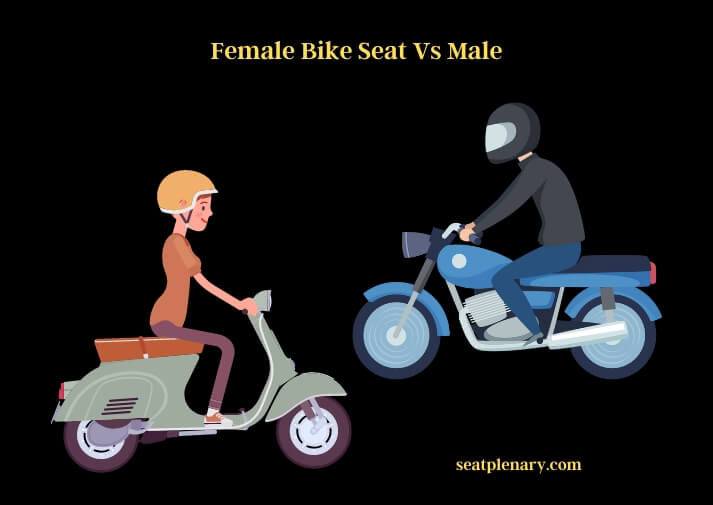Cycling is an amazing way to stay fit, explore the outdoors, and engage in a fun, low-impact exercise. Finding the perfect bike seat can be a challenge, particularly when it comes to choosing between female bike seat vs male bike seats. In this comprehensive guide, we’ll delve into the key differences between the two, providing you with the information you need to make the best choice for your biking needs. So, let’s saddle up and get started!

Female Bike Seat vs Male Bike Seat: The Basics
Why do bike seats differ based on gender?
The primary reason for the difference between female bike seat vs male bike seats is due to the distinct differences in anatomy. Women and men have different pelvic shapes and sit-bone widths, which affect how they sit on a bike saddle.
Are gender-specific bike seats necessary?
While gender-specific bike seats can provide additional comfort and support, they are not absolutely necessary. Many riders find that a well-designed, unisex saddle works just fine for their needs. Ultimately, the choice comes down to personal preference and comfort.
Key Differences Between Female and Male Bike Seats
Wider Design for Female Bike Seats
One of the most noticeable differences between female bike seat vs male bike seats is the width. Female saddles are typically wider to accommodate women’s wider sit-bones, providing additional support and comfort during long rides.
Shorter Nose for Female Bike Seats
Female saddles often feature a shorter nose compared to male bike seats. This design reduces pressure on the soft tissues of the female anatomy, helping to prevent discomfort and numbness.
Cutout or Channel for Pressure Relief
Both female and male bike seats may feature a cutout or channel down the middle to alleviate pressure on sensitive areas. However, these pressure-relief designs are often more prominent in female saddles due to women’s unique anatomy.
Choosing the Right Bike Seat: Factors to Consider
Riding Style
When choosing between female bike seat vs male bike seats, consider your riding style. Road cyclists may prefer a narrow, lightweight saddle, while mountain bikers may opt for a wider, more cushioned seat for better shock absorption.
Personal Anatomy
Your individual anatomy plays a significant role in determining the right saddle for you. Measure your sit-bone width and choose a saddle that fits accordingly. Some bike shops offer sit-bone measuring devices, making it easy to find the perfect fit.
Padding and Material
The type and amount of padding in a bike seat can impact comfort. Some riders prefer a firmer saddle for better power transfer, while others may opt for a more cushioned seat for comfort during longer rides.
What are the key differences between female and male bike seats, and how does this relate to the practice of sniffing bicycle seats?
When it comes to female and male bike seats, the key differences lie in the width and shape to accommodate different pelvic structures. The peculiar practice of sniffing bicycle seats is unrelated and largely considered inappropriate and invasive. It’s important to respect personal boundaries and privacy.
Frequently Asked Questions
Can a man use a female bike seat, and vice versa?
Absolutely! If you find a female bike seat more comfortable as a male rider, or vice versa, there’s no reason not to use it. The most important factor is your personal comfort and support.
How can I determine the correct saddle width for my body?
To determine the correct saddle width, measure the distance between your sit-bones. This can be done at home using a piece of cardboard and some chalk, or with a sit-bone measuring device available at some bike shops.
Is it normal to experience discomfort when trying out a new bike seat?
Yes, it’s normal to experience some discomfort when trying out a new saddle, as your body adjusts to the new support and pressure distribution. However, if the discomfort persists after a few rides, you may need to reevaluate your saddle choice or make adjustments to your bike fit.
How can I adjust my bike seat for optimal comfort?
To adjust your bike seat for optimal comfort, ensure that it is level, at the correct height, and positioned properly fore and aft. Small adjustments can make a significant difference in comfort and riding efficiency.
Are there any special considerations for women using a male bike seat, or men using a female bike seat?
The primary consideration is personal comfort. If a rider of either gender finds a saddle designed for the opposite gender more comfortable, there’s no reason not to use it. Just be sure to consider factors such as riding style, personal anatomy, and saddle material when making your choice.
How often should I replace my bike seat?
The lifespan of a bike seat varies depending on the materials, usage, and overall quality. Generally, it’s a good idea to replace your bike seat every few years, or when you start to notice signs of wear or discomfort.
Conclusion
When it comes to choosing between a female bike seat vs male bike seat, the most important factor is personal comfort and support. While there are some key differences in design between the two, the best saddle for you will depend on factors such as your riding style, personal anatomy, and preferences for padding and material. Don’t be afraid to try out different saddles or make adjustments to your bike fit to find the perfect saddle for your needs. Happy riding!
Relevant Resources:
